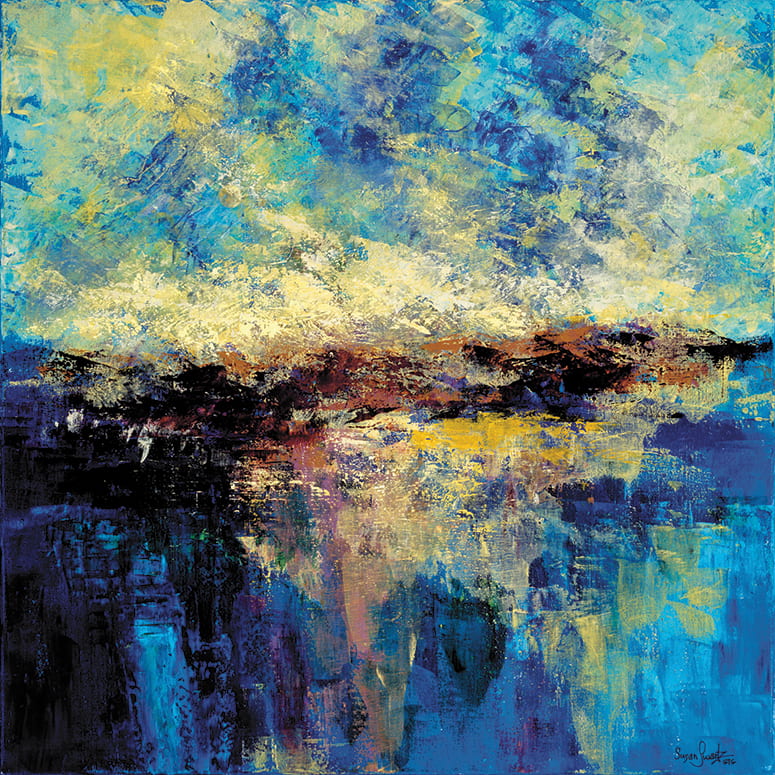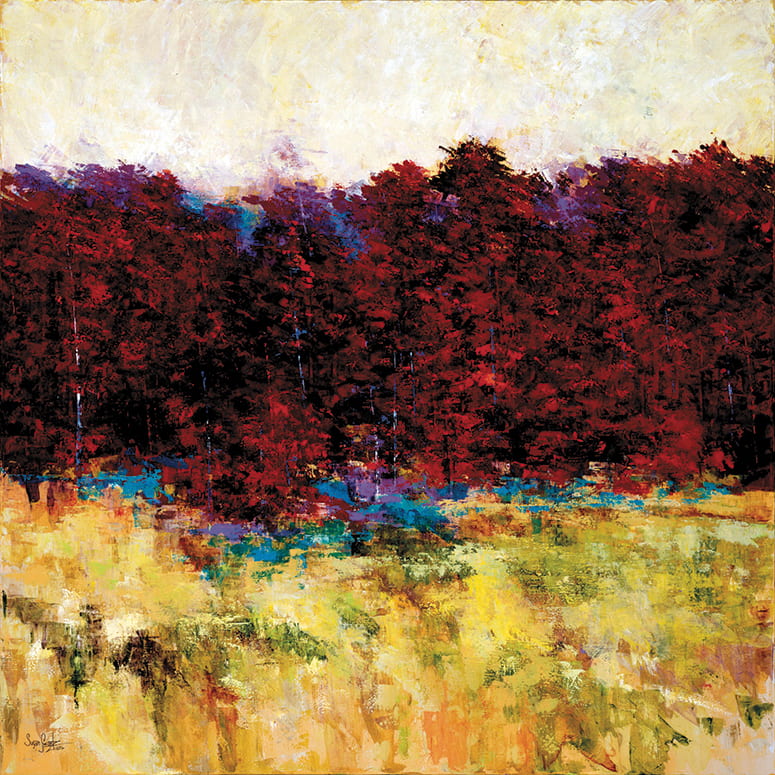In Review
Reading the ‘Book of Nature’
By William A. Graham
“Natural revelations,” Susan Swartz’s recent exhibit and related book, continues the venerable tradition of artists who find in nature their prime window on the divine. I comment on it, not as an art specialist, but rather as a historian of religion noting the links among art, religion, and nature that her work might suggest—and it may help a bit that I am very much at home in the outdoors, especially in the mountain world of rock, forest, lakes, and snow that frequently appear in Susan Swartz’s paintings. “Natural Revelations” suggests—intentionally or unconsciously, but very much in fact—numerous worldwide traditions involving the religious understanding of nature as a primary witness to transcendence.
The global history of religion testifies again and again to the powerful, often revelatory or inspirational roles that the wonders and, yes, terrors of nature have played in our shared human experience. Swartz’s electrifying paintings focus in particular on the wonders and the magnificence—an emphasis that echoes the oldest spiritual and aesthetic intuitions of our species. Her art radiates the conviction that nature reveals that which transcends our physical universe and our fragile experience as mortal beings in perilous passage through a world vastly larger than ourselves or even our imagining.

Afterglow, 36 x 36, acrylic on linen.
“Natural Revelations” also echoes the major theme, especially pronounced in Jewish, Christian, and Islamic monotheism, of the “book of nature” as a tactile source of divine revelations that is analogous to (and of course even antecedent to) verbal divine revelations in the “book of scripture.” Ralph Waldo Emerson expresses this idea as follows: “Nature is a language and every new fact that we learn is a new word; but rightly seen, taken all together it is not merely a language but the language put together into a most significant and universal book.”1 In the West, the idea is of course much older: Ernst Robert Curtius famously traced its history back to the Middle Ages, or even to Plotinus, who said that his own art was “to read the written characters of Nature. . . .”2
Another vivid example of this “book of nature” as analog to the “book of scripture” can be found in the Islamic tradition in the usage of the qur’anic text itself. The word that the Qur’an uses for the units of revelation, the individual verses of its text, is ayât (sing., ayah), which is exactly the same word the Qur’an also employs for the patent signs of God in the natural world. Thus God’s revelations to humanity are found both in his signs in nature and in his signs in scripture. The Qur’an constantly reminds us that our world overflows with clear tokens of God’s creative and sustaining power. Furthermore, it portrays God’s creation as naturally engaged in perpetual praise of him: birds on the wing; rain after drought; wind on the sea; mountains lifted up against the sky; the alternation of sun and moon, day and night; even the shadows of trees that prostrate themselves on the ground in the low light of dawn and sunset—all are understood to be worshiping their creator in their natural activities and orientations. Consequently, the “signs of God” in both nature and scripture testify to God’s power and majesty. Those who have eyes to see and ears to hear are presented with clear tokens of God and his sovereignty both in his creation itself and in his explicit verbal revelations.
The idea of revelation usually references a supreme divinity as its source, but it is also the case that a perceptive scientist may reject God yet still marvel at what nature “reveals” to the careful investigator. Witness the almost reverent words of the renowned biologist E. O. Wilson, who would hardly describe himself as religious:
We took a wrong turn when we launched the Neolithic revolution. We have been trying ever since to ascend from rather than to Nature. It is not too late for us to come around, without losing the quality of life already gained, in order to receive the deeply fulfilling beneficence of humanity’s natural heritage.3
Wilson’s “deeply fulfilling beneficence” is what the religiously sensitive perceive as more than nature’s gift alone. For me it recalls Albert Schweitzer’s Reverence for Life, Ehrfurcht vor dem Leben, a religious ethic that sees all life-forms as God-given and thus worthy of (and requiring) our reverence. For me, “religion” can be described well as most fundamentally the conviction that there is more to the world than meets the eye—a “more” that transcends both humanity and nature. Susan Swartz’s art portrays nature as the realm par excellence where humanity encounters that transcendence. In nature she finds God’s visible—indeed, his brilliantly visible—hand. The spiritual lens she turns on the natural world and her joyous, expansive response to the glories of creation speak quite differently, but no less evocatively, than other great nature art, from an Altamira cave painting or Chinese landscape to a Bierstadt panorama or one of Cezanne’s landscape vistas. Her paintings recall us positively to what is good, true, beautiful, and, yes, sacred, in the natural world we inhabit but too often fail to appreciate.

Amazing Grace, 72 x 72, acrylic on linen.
Artists are often likened to prophets, as they intuit and reveal things the rest of us cannot otherwise see or fail to interpret adequately. When we contemplate Swartz’s abstract visions in “Afterglow” and “Heaven,” or her more naturalistic “Amazing Grace” and the “Autumn’s Bounty” triptych, “revelatory” does not seem an out-of-place attribute—whether you find the revelation to be of God’s hand or simply, with E. O. Wilson, nature’s “deeply fulfilling beneficence.” Swartz’s very titles reference her own faith, just as her signing of each work with “Glory to God” reminds us that she intends her visions of nature to be, in William Wordsworth’s phrase, “intimations of immortality.” Even the nonbeliever has to see in a work such as her “Purple Majesty” a stunning revelation of the transitory world of natural change over against the eternal backdrop of sun, sky, and finally the wider universe.
Swartz reads nature’s book most acutely through uncanny renderings of aspens, wildflowers, fall colors, and blue waters. However, her work also pushes us beyond purely naturalistic images of tree trunks, pastel flowers, autumn leaves, and windy seas. In it we find natural objects transfigured through the play of light and shade by a reverent eye into something more, reflecting something beyond nature. There is little of traditional “naturalism” in her often abstract work, but much that is at once natural and more-than-natural. Swartz sees in nature’s displays truly “more than meets the eye”—and she pushes us to share her visions of divine gifts, to see the “more” offered all about us, to hear nature telling us that, as the poet Mary Oliver puts it in “Wild Geese”:
the world offers itself to your imagination,
calls to you like the wild geese . . .
over and over announcing your place
in the family of things.
Swartz’s paintings startle us with their intensity and brilliance, serving as lenses on nature’s breathtaking beauty. In doing so, they call us back to our own remembered encounters with nature and, for many of us, nature’s source.
Susan Swartz’s paintings enable us to stand with her apart from nature while simultaneously seeing it anew, in the light of her deep awareness of its creator and sustainer. Whatever our personal faith or philosophy, her work reminds us, as the American nature traveler Estwick Evans noted in 1818, that “there is something in the very name of wilderness which charms the ear, and soothes the spirit. . . . There is religion in it.”4 When we step into the kaleidoscopic world of Susan Swartz’s paintings, it is hard not to feel that she shares this view.
Notes:
- Journals of Ralph Waldo Emerson, 1820–1872 (Houghton Mifflin, 1910), 3:227.
- Ernst Robert Curtius, European Literature and the Latin Middle Ages [German original, 1948], trans. W. R. Trask (Princeton, 1973), 319–26, quote on 308.
- E. O. Wilson, The Creation: An Appeal to Save Life on Earth (Norton, 2006), 13.
- Estwick Evans, A Pedestrious Tour of Four Thousand Miles through the Western States and Territories during the Winter and Spring of 1818 (1819), 102.
William A. Graham is Dean and John Lord O’Brian Professor of Divinity at HDS, and Murray A. Albertson Professor of Middle Eastern Studies in the Faculty of Arts and Sciences, Harvard University. He gave this talk at the opening of the exhibit “Natural Revelations,” at the Utah Museum of Fine Arts, Salt Lake City, January 10, 2008.
Susan Swartz is an artist whose paintings have won international awards and recognition; her work is part of permanent collections in several museums. Her latest exhibit, “Seasons of the Soul” at the National Museum of Women in the Arts in Washington, D.C., runs through October 2, 2011. More of her paintings may be seen at www.susanswartz.com.
Please follow our Commentary Guidelines when engaging in discussion on this site.

